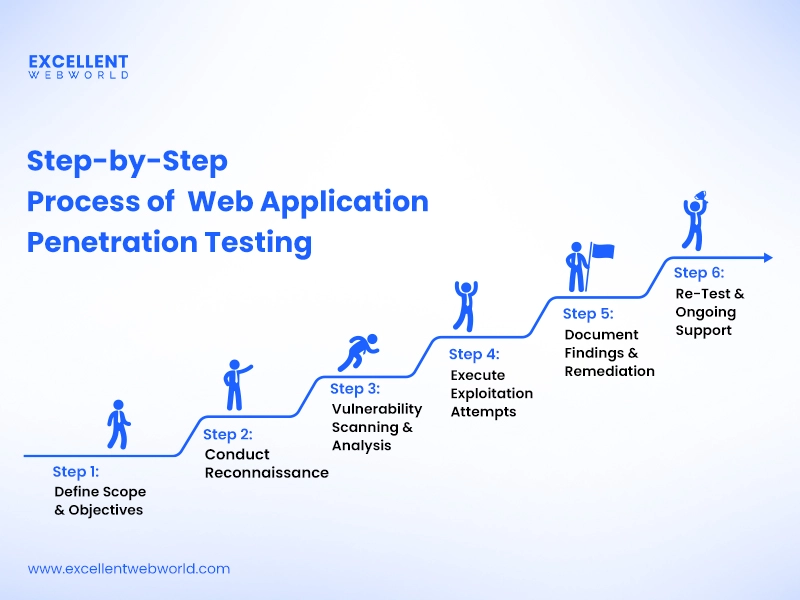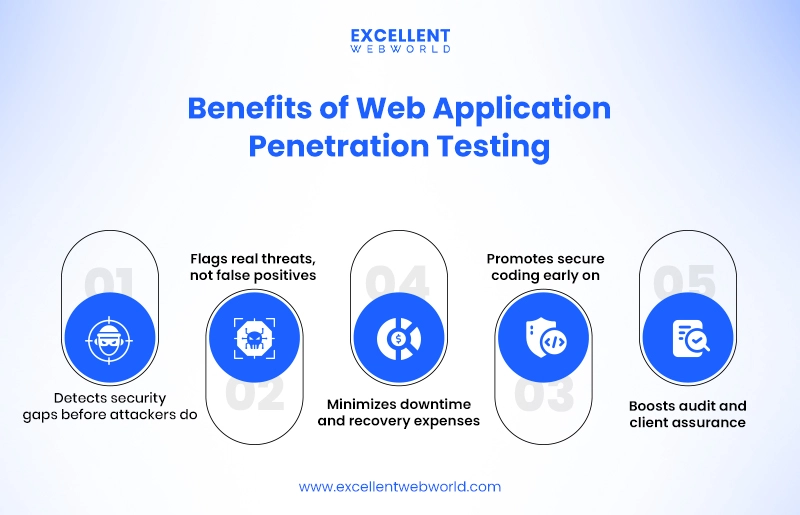Is your web application truly secure, or does it only appear that way without proper Web Application Penetration Testing?
Most attackers do not rely on sophisticated exploits. Instead, they focus on overlooked flaws that slip through during development and remain unnoticed.
According to the 2024 Edgescan Vulnerability Statistics Report, 12.8% of vulnerabilities found in web applications and APIs are classified as critical or high severity.
Even a single misconfigured role or unchecked API input can expose your entire system. By the time such vulnerabilities are discovered, often during audits or after a breach, it is usually too late.
This is where Web Application Penetration Testing becomes essential. It simulates real-world attack scenarios to uncover and fix security gaps before they are exploited.
In this guide, we will explain what Web Application Penetration Testing is, outline the complete process, list popular tools, and share expert tips to help you strengthen your application security.
What Is Web Application Penetration Testing?
Web application penetration testing is a controlled assessment where security experts mimic an attacker’s behavior to identify potential vulnerabilities in a live web application. Rather than heavily relying on automated scans, web app pentesting uses manual techniques to detect logic flaws and configuration issues that attackers exploit.
For example, take an e-commerce website where users view their past orders. A tester manually alters the URL from “/orders?user=123” to “/orders?user=124”. Without strict permission validation, the application exposes another user’s information. This kind of flaw is known as broken access control, which is most probably missed by scanners but exposed during web app penetration testing.
So, why is web application security penetration testing performed in the first place? Simple, because attackers mostly rely on overlooked errors and not zero-day exploits. Attackers exploit log gaps and missed validations that slipped through during web development. This is why security testing should be considered early, even while you’re evaluating different web app ideas for your next product.
Let’s check out the different types of penetration testing for web applications.
Types Of Web App Penetration Testing
You know that every app does not require the same testing approach, right? Different tests are suited for different web application goals and structure. Companies usually select penetration testing services based on the level of access, security objectives, and compliance requirements. Here are all the types of web application penetration testing.
1. Black Box Penetration Testing
Black box penetration testing replicates the behavior of an outsider with zero to no access to the internal structure or credentials of the application. The tester’s maximum times rely on external observations and open-source intelligence.
2. White Box Penetration Testing
White box penetration testing includes an in-depth examination of the web app’s internals. With complete access, testers detect vulnerabilities buried within either authentication flows or data handling.
3. Gray Box Penetration Testing
Gray box penetration testing represents a threat actor with partial to limited access, like a basic user or insider with restricted information. This approach helps identify risks that are tied to session management or user role abuse.
To improve coverage of user behavior and interface flaws, organizations pair this with usability testing tools during broader testing phases. If you want more information regarding the types of web app pentesting, read this table.
| Pentesting Type | What’s Known | Why It’s Used | When It’s Used |
|---|---|---|---|
| Black Box Pentesting | The tester works without system knowledge | Evaluates how well the app defends against anonymous threats | During assessments of apps open to the public |
| White Box Pentesting | Full access to the codebase and infrastructure | Helps locate insecure development patterns and hidden issues | In early SDLC stages for code-level assurance |
| Gray Box Pentesting | Partial access without full backend visibility | Identifies mid-level flaws not visible externally | For applications with tiered roles or internal users |
Here are some extra classification types in web application pen testing.
Once you select the testing type based on your goal and risk profiles, what follows is a structured process. If your application is developed by a web app development company, aligning your testing steps with their architecture decisions helps identify deeper flaws. Let’s check out the entire process.
What Is The Step-by-Step Web Application Pen Testing Process?
Every test must follow a systematic flow to be accurate and actionable. Not following so leads to missed vulnerabilities or false assumptions. Here is the step-by-step process of web application pen testing.
Step 1. Define The Scope And Objectives (Planning & Scoping)
The most important discussion before testing starts is setting boundaries around what is within the scope and what is not. Skipping this part or handling it poorly results in gaps in testing and unnecessary rework.
If you test a CRM without knowing whether admin areas or external plugins are included, major risks could go undetected. Both technical leads and business owners participate in this stage to set clear testing goals and constraints. Here are the actions you need to consider.
After aligning on scope, planning moves forward with finalizing timelines and implementing secure lines for ongoing coordination. This is specifically followed when the testing involves sensitive environments tied to cloud security.
Step 2. Conduct Reconnaissance (Passive & Active)
Consider this a surveillance phase. Testers have not started attacking yet. Their job now is to collect data, not unlike how someone might study security patterns before acting. At this stage, the approach splits into passive and active reconnaissance techniques.
| Passive Reconnaissance | Active Reconnaissance |
|---|---|
| Observing without touching the app directly | Engaging with the app to gather live information |
| Using tools like Shodan, public WHOIS records | Using Nmap scans, directory brute-forcing |
| Looking at job listings or open GitHub repos | Sending crafted requests to endpoints |
| Gathering metadata, framework info, and emails | Mapping input fields, cookies, and server headers |
This phase helps you get a clear picture of the application’s structure and tech stack. The focus is on the silent collection of information available to outsiders. By now, testers have a detailed footprint with possible vulnerabilities and open services. Now begins the process of verifying which areas are at risk.
Step 3. Perform Vulnerability Scanning And Analysis
As soon as the reconnaissance data is compiled, testers start identifying real issues within the web application. At this point, automated scans are paired with manual checks to filter out false alerts from true threats.
Platforms like OWASP ZAP and Nessus scan for issues that might include old code, suspicious inputs, or misconfigured settings. Still, automated results are just the starting point. Experienced testers then review each one to understand:
This depth of analysis is important when evaluating a web app compared to a mobile app, as the architecture, threat surface, and data exposure vary between the two. The primary components reviewed at this stage include:
Quantity means little here. It’s the careful evaluation that separates minor bugs from high-risk threats.
Step 4. Execute Exploitation And Access Attempts
Let’s say a tester identifies an endpoint vulnerable to SQL injection. It’s not enough to simply document the issue and leave it at that. Here, testers try to exploit the vulnerability much like a real attacker to assess its actual consequences.
The goal is not to show it exists but to reveal how far it reaches. Does it leak a few records, or does it allow database-level control? The severity of the impact sets the priority for remediation. Check out some frequently used techniques during this phase.
Testers also watch how the application responds under real pressure, looking for unexpected errors or odd responses that hint at deeper issues. This phase delivers proof of exploitability. It answers the question, “If a vulnerability exists, what could happen if someone took advantage of it?”
Step 5. Document Findings And Recommended Remediation
Following exploitation, attention turns towards detailing the issues and guiding the fix process. The web application security testing is only useful if the results make sense to both technical teams and leadership alike.
The document must connect the dots between what went wrong, why it’s important, and how to resolve it using clear explanations. Check this example of how findings and fixes are generally presented:
| Finding | Recommended Fix |
|---|---|
| Password reset endpoint lacks rate limiting | Implement throttling to prevent brute-force attempts |
| SQL injection in the login field | Use parameterized queries instead of dynamic SQL |
| Admin panel exposed via predictable URL | Add authentication and obscure sensitive routes |
| Insecure cookie attributes | Set HttpOnly, Secure, and SameSite flags |
What defines an effective test is how well the report translates issues into action steps, prioritizing by risk. Having a well-defined web development team structure helps ensure those fixes are handled quickly and by the right people.
Step 6. Re-Test & Provide Ongoing Security Support
Applying fixes does not guarantee that the problem is entirely gone. A follow-up test is necessary to verify that the vulnerabilities were addressed. Testers return to the initial findings and repeat the exploitation steps. If vulnerabilities exist, testers document them with added notes on why the patch may have failed.
A successful fix does not mean you are in the clear. Code updates or partial fixes introduce new risks, so testing must continue over time. Businesses working with confidential data or shipping features must follow a consistent testing schedule. Doing so strengthens security in the long term.
Also, continued services may include reviewing hotfixes, providing technical input, or helping with compliance. True security stays active with every product change.
Tools Used For Web Application Penetration Testing
Web application pentesting includes multiple phases. From reconnaissance to reporting, each stage requires specific web app penetration testing tools. Let’s learn about each tool along with its purpose and key functions.
| Category | Tools | Purpose | Key Functions |
|---|---|---|---|
| Reconnaissance Tools | Nmap Shodan | Identify exposed systems, services, and devices before attacking | |
| Vulnerability Scanners | OWASP ZA Nessus | Detect known weaknesses in applications and configurations | |
| Exploitation Frameworks | Burp Suite Metasploit SQLMap | Launch controlled attacks to validate whether vulnerabilities can be exploited | |
| Reporting & Collaboration | Dradis Faraday | Organize results, collaborate across teams, and generate actionable reports |
If you are using the right combination of tools, then it helps you reduce manual efforts and support faster remediation planning.
What Are The Benefits Of Web Application Penetration Testing?
If your team is only running surface-level tests, then you are likely missing what matters. Here are the benefits associated with web application penetration testing that go beyond security checks.
1. Identifies Security Weak Points Before Attackers Do
Web application penetration testers recreate the real attack behavior to identify hidden flaws during web app development. Many of these stem from insecure web application architecture, like broken authentication flows or weak session handling. These gaps bypass attention during initial development.
2. Helps Prioritize Real Risks Over False Alarms
As you know, many tools trigger warnings based on patterns and not impact. What penetration testing does is it filters those out and highlights vulnerabilities that could contribute to compromising the application if those are not addressed.
3. Reduces Business Downtime and Recovery Costs
If vulnerabilities are not identified properly, then these vulnerabilities lead to data loss or legal implications. Pentesting makes it easier by identifying weak points early to avoid these disruptions and lowers the cost of emergency patching or damage control.
4. Supports Secure Development From the Start
Performing penetration testing in pre-release cycles gives web developers early feedback on insecure structures or user flows. Such an approach reduces rework efforts and ensures quick resolutions without delaying release timelines.
5. Builds Compliance Confidence With Auditors and Clients
Regulatory standards, including SOC 2, PCI DSS, or OWASP ASVS, require periodic pentests as a security benchmark. These test reports show auditors and clients that your security is constantly assessed and improved.
Best Practices For Effective Web App Penetration Testing
Even with the right tools, poor execution leads to incomplete testing and missed threats. Here are the best practices to follow if you want effective web app penetration testing.
1. Always Test In An Isolated Environment
What you can best do is to perform all penetration tests in a separate staging environment that mimics your live system. Prioritizing such an approach helps you avoid risks like data leaks or unintentional service outages.
2. Document Scope & Responsibilities
Ensure all the things containing endpoints, API routes, and user access levels are part of a defined scope. You can also include who is responsible for coordinating during the test, evaluating results, and applying remediations.
3. Use A Combination Of Manual And Automated Testing
Automated scanners fail to catch vulnerabilities tied to custom logic or non-standard logic. Manual testing helps as human testers understand flow, intent, and logic in ways tools cannot. So, opt for both approaches, manual and automated testing.
4. Keep Up With CVEs And Exploit Trends
Pull out the latest data from trusted vulnerability feeds and CVE databases when planning each test cycle. Staying updated helps your team find vulnerabilities that attackers are actively targeting.
5. Validate Remediation With Follow-Up Testing
Doing it again doesn’t mean wasting time. Retesting verifies whether patches worked and checks if nothing was missed or broken. If a vulnerability remains, testers document it and suggest remediation alternatives.
Best practices might guide the entire process, but your results depend on how the testing is carried out. Let’s help you decide which approach is appropriate for your requirements.
Manual vs. Automated Web Application Penetration Testing
Effective penetration testing for web applications requires a mix of manual and automated methods. Your choice between these tests depends on the vulnerabilities and the application’s structure.
| Criteria | Manual Testing | Automated Testing |
|---|---|---|
| Accuracy | High, with fewer false positives | May include false positives |
| Depth of Testing | Can detect complex logic flaws | Focused on known patterns and CVEs |
| Speed | Slower, it depends on the tester’s skill | Fast, suitable for wide coverage |
| Resource Requirement | Needs skilled professionals | Can be run with minimal human involvement |
| Ideal Use Cases | Custom workflows, authentication, and business logic bugs | Regular scans, common vulnerabilities, and regression tests |
Automated testing is perfect for repetitive scanning and broad coverage. Manual testing is perfect at catching logic flaws and complex bugs. When both are combined, the results are a more reliable and thorough penetration testing process.
Web Application Pen Testing Checklist
A clear and detailed checklist ensures every security area is tested, and nothing critical is overlooked during the web app or website penetration testing process. From initial setup to confirming fixes, every phase demands specific checkpoints. Let’s check each of those checkpoints in detail.
Pre-Engagement
Information Gathering
Vulnerability Discovery
Exploitation
Post-Exploitation
Reporting & Retesting
Whether you are testing internally or hiring an external team, this checklist provides clarity and control to the process.
Make Web Application Security a Continuous Priority
A single assessment falls short when threats evolve faster than defenses. As a recognized AI-driven app development company specializing in providing reliable cybersecurity services, we apply offensive security techniques to assess vulnerabilities within your entire application stack. From fintech to healthcare, our testers adapt to your industry and compliance standards.
If you are the one looking to carry out pen testing for your web application, contact us. Our team supports security efforts, whether you are scaling apps or infrastructure.
Frequently Asked Questions
A web application penetration test is a simulated attack used to uncover and assess vulnerabilities in a web-based system. The goal is to reveal how attackers exploit coding flaws or logic errors. The findings support developers and security teams in strengthening web application security.
Here are the five stages of penetration testing.
The first step involves mapping out user roles, APIs, endpoints, and exposed services. Testers then simulate attacker behavior to evaluate what data or access could be compromised. And at last, a report is created listing each issue with severity levels and steps for remediation.
On one side, OSSTMM provides a detailed methodology for performing security testing with multiple domains, not limited to just web applications. On the other side, OSSTMM is used across broader security domains, including physical, wireless, network, and human-based systems. OWASP is flexible and adopted in Agile teams, while OSSTMM follows a structured and auditable format.
The timeline for web penetration testing ranges from 7 to 14 business days. The exact timeframe depends on the following factors:
Here are the steps you can follow when choosing a web application penetration testing service.
Here is the process to pen test a website.

Article By
Mahil Jasani began his career as a developer and progressed to become the COO of Excellent Webworld. He uses his technical experience to tackle any challenge that arises in any department, be it development, management, operations, or finance.






